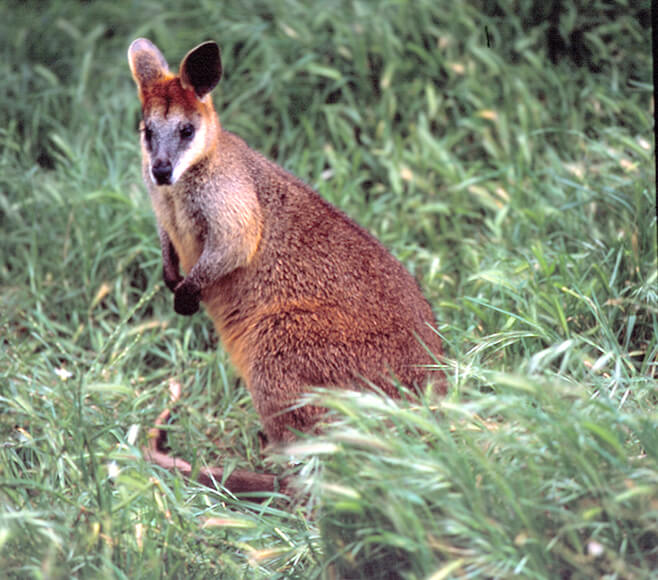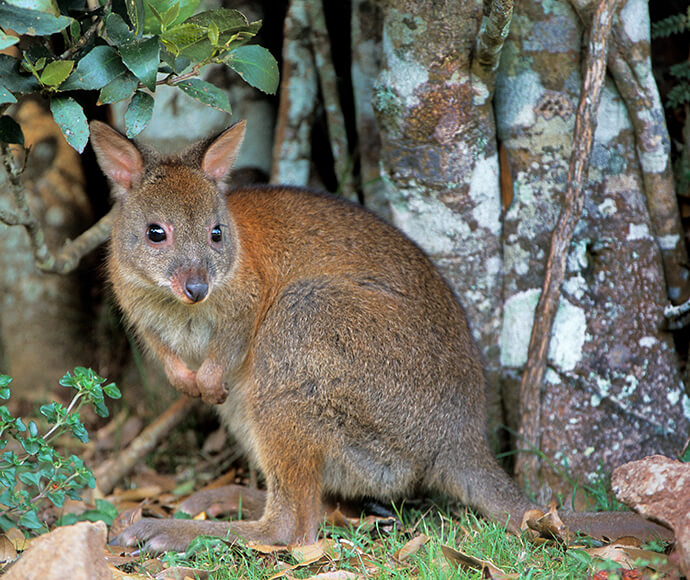What do they look like?
Kangaroos and wallabies are marsupials that belong to a small group of animals called macropods. They are only found naturally in Australia and Papua New Guinea. Most macropods have hind legs larger than their forelimbs, large hind feet and long muscular tails which they use for balance. The word macropod actually means 'big foot'. Kangaroos and wallabies are most active at night, dusk and dawn.
Kangaroos and wallabies (and possums) have forward-opening pouches. Other marsupials, such as wombats and koalas, have pouches that open backwards.
Kangaroo superfamily
The kangaroo superfamily consists of 2 family groups. Kangaroos, wallabies, pademelons and tree kangaroos make up one family, while rat-kangaroos, bettongs and potoroos make up the other. There are 45 species of kangaroos and wallabies.
Where do they live?
Kangaroos and wallabies live just about everywhere!
- Red kangaroos are found on the flat open plains.
- Grey kangaroos overlap the reds but prefer denser scrubs and forests.
- Wallaroos have an extensive range throughout the inland but prefer rocky outcrops or stony ground.
- Rock-wallabies live among piles of boulders, rocky hills and cliffs.
- Tree-kangaroos (2 species of which live in Australia) are found in the mountainous rainforests of north Queensland.
- Smaller species of wallabies and kangaroos live in a wide range of habitats, from desert to woodland to rainforest.
Threats
Kangaroos and wallabies once roamed Australia practically undisturbed by predators, although no doubt the Tasmanian tiger and other carnivorous marsupials were a threat to their safety. The arrival of Aboriginal people between 40,000 and 60,000 years ago had an impact on kangaroos and wallabies through hunting and frequent burning of habitat vegetation. The dingo, which arrived about 3,500 years ago, became a major kangaroo predator.
However, the arrival of European settlers had the greatest effect on native animals, including kangaroos. European livestock compete with kangaroos for pasture, and introduced species such as foxes, cats and dogs prey on native fauna. Different bushfire patterns have also had a great impact on kangaroo habitat.
Two centuries ago there were 21 species of macropod in New South Wales; now there are only 15. The smallest species, and those with special habitat requirements and restricted ranges, have suffered the most, both from predators and from the destruction of their habitats. A number of species of kangaroo and wallaby are listed as threatened in New South Wales.
Kangaroos and livestock
Not all developments since the arrival of Europeans have been bad for kangaroos. Numbers of some of the large species have increased greatly in parts of the inland since European settlement. One possible reason for this is that bores and ground tanks have provided kangaroos with water in places that would previously have been uninhabitable. Kangaroos usually do not stray more than 10 to 15 km from water.
Kangaroos are most numerous in the better-class rangelands and are less common in very arid country.
As a general rule, kangaroos and sheep eat different plant species, so they are not often in direct competition if there is plenty of food. Kangaroos eat young green shoots high in protein – they are not as good as sheep are at eating and digesting dry grass or fibre. In dry periods, however, kangaroos can sometimes reduce the amount of feed available to livestock. Being more mobile than sheep, they can select the best vegetation in an area for themselves.
Managing kangaroo populations
The Department of Climate Change, Energy, the Environment and Water aims to strike a balance between conserving all macropod species, managing damage caused to privately owned land and environmental sustainability.
To achieve this, we use non-commercial and commercial programs. Non-commercial culling by private landowners is regulated through damage mitigation permits issued by the National Parks and Wildlife Service. Commercial harvesting is regulated under the Kangaroo Management Program, approved by the Australian Government Minister for the Environment.
More information is available on the NSW Commercial Kangaroo Management Program and applying for a licence to harm kangaroos.
Living with kangaroos
Kangaroos, particularly those at the interface between residential and rural lands, often come into contact with people and may exhibit complex behavioural responses which can be misunderstood, raise concern or on very rare occasions lead to physical injury. Although the chances of being harmed by a kangaroo are very low, there are things you can learn about kangaroo behaviour and strategies you can put into place around the home and community that can reduce the risk of negative interactions with these iconic animals.
Protection of native animals
All native birds, reptiles, amphibians and mammals, but not including dingoes, are protected in New South Wales by the Biodiversity Conservation Act 2016.









